The morning dew dampens my sneakers as we ascend the green, undulating hill. Jerry Eisterhold, wearing a wide-brimmed hat against the Missouri summer sun, pulls a bunch of grapes of a type known as Delicatessen off the vine. “I got this one from a guy who should have won an amateur wine competition,” he says. “But the flavors were so unusual, the judges didn’t know what to do with it.”
Eisterhold, 72, is giving me a tour of what might be America’s most unusual vineyard. He leads me through rows upon rows of grapes—varieties with names that haven’t appeared in wine stores in generations, if ever. There’s Captivator, Amerbonte, Marguerite.
As we stroll, Eisterhold gestures here and there, affably extolling his grapes and explaining their quirks and characteristics. In one row he stops to inspect his Rommel vines, which are growing poorly this year, and points out little bumps on the leaves—a telltale sign that Japanese beetles are getting to them. “But we forgive it its sins,” he says, of the grape’s susceptibility to the common vineyard pest. “It makes a nice white with tannins.”
Eisterhold is convinced that Missouri can help revitalize the global wine industry—again. Jenn Ackerman + Tim Gruber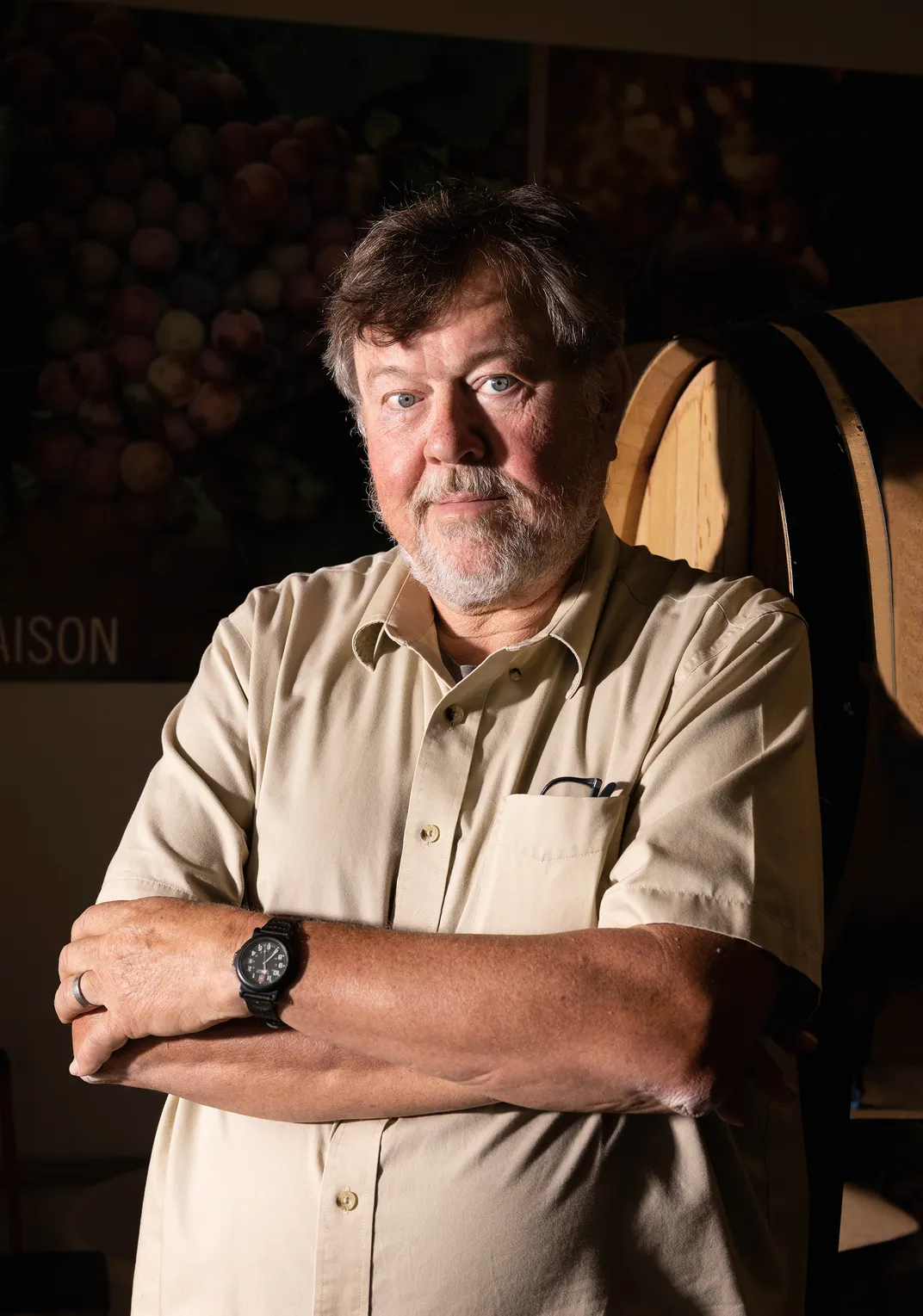
An aerial photo of sun-dappled rolling hills of TerraVox’s 14-acre vineyard, not far outside Kansas City, Missouri. Jenn Ackerman + Tim Gruber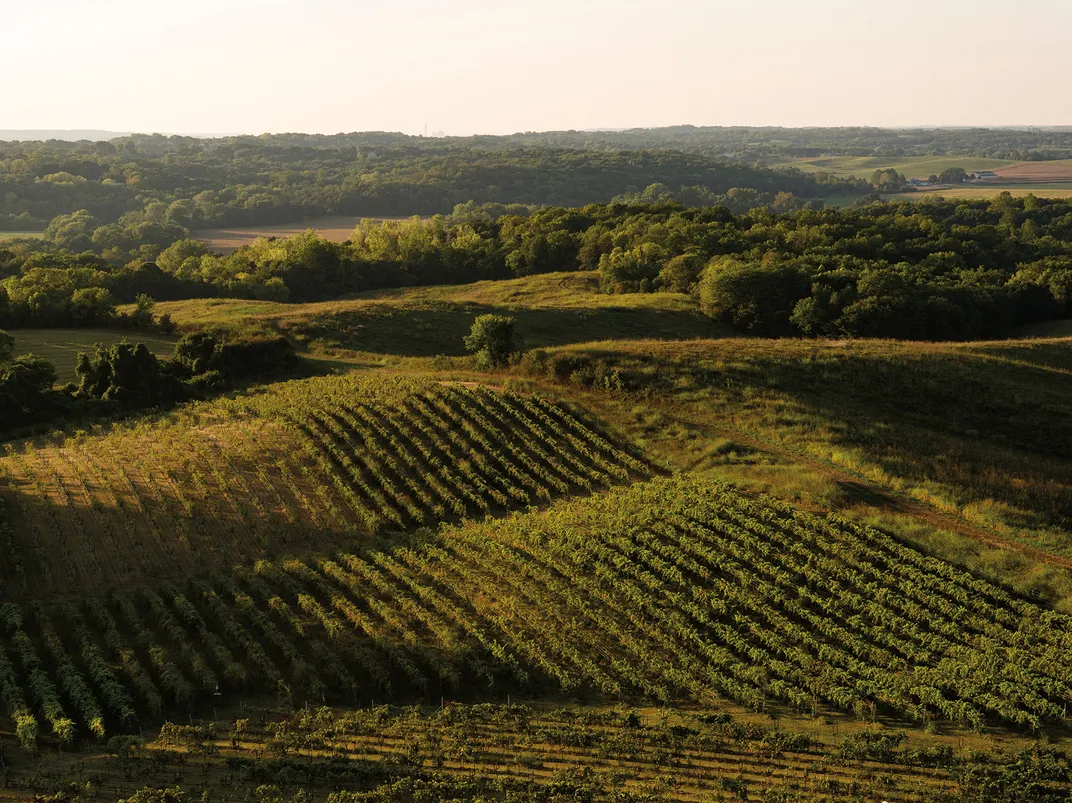
Eisterhold’s day job is designing museum exhibitions, but he has spent decades accumulating this collection of grapes that—despite an illustrious past—have been largely forgotten and were very nearly lost. His winery, TerraVox, situated on rolling hills just outside Kansas City, is a commercial business. Guests arrive most weekends for tastings, and local restaurants and bars sell TerraVox wines. But unlike most wineries, which specialize in a dozen or fewer popular grapes, TerraVox’s modest 14 acres grow around 40 varieties, most of them practically unknown—and all of them native to North America. It’s a wildly inefficient business model, but profit has never been the point. Instead, Eisterhold describes TerraVox, likely the only winery devoted exclusively to American grapes, rather than the European grapes grown in regions like Sonoma, California, as a “living museum.”
Long before California’s Napa Valley established its international reputation, Missouri was America’s leading wine region—the legacy of German immigrants who founded the town of Hermann, whose rocky soil and abundance of wild grapes inspired them to trade agriculture for viticulture. In the late 19th century, Missouri produced more wine than any other state, and Hermann’s Stone Hill Winery—famous for making one of the world’s best-selling wines—won seven gold medals at world’s fairs between 1873 and 1901. One of France’s most renowned wine critics wrote that the U.S. was “destined to become … one of the great wine-producing regions of the world,” and called out Missouri in particular as having the most prolific vineyards and “yielding the best wines.”
Prohibition swept it all away. “Even now the picturesque vineclad hills are being dismantled of the vineyards that for half a century have added beauty, fame and wealth to the community,” a Missouri newspaper lamented in May 1919. Hermann residents replaced the grapes with broomcorn, and Stone Hill Winery turned its cellars into mushroom farms.
After the end of Prohibition and World War II, Missourians replanted some local grape varieties. Stone Hill reopened in 1965, and hobbyists across the state harvested once again. Restarting from scratch, however, many Missouri wineries settled into a niche of producing cheap, sweet wines, as most Americans who could afford to bought European wine, which was increasingly easy and affordable to import by steamship.
Still, local wine culture endured. Eisterhold was raised on his family’s farm in the Gasconade River Valley, not far from Hermann, where the family tended subsistence crops of corn, wheat, oats and alfalfa—and where Eisterhold grew up making wine along with his parents and five siblings. There was nothing fancy about the hobby. “You’d get a very tall ladder, climb up a 50-foot-tall tree and cut down wild grapevines,” Eisterhold remembers. “To this day, I can recall those flavors. It was pretty solid wine.”
As an adult, he continued to make wine from grapes he grew in his backyard in his spare time. Then, one afternoon in the early 1980s, when Eisterhold was in his 30s, he traveled to Lincoln, Nebraska, for business. He was perusing a used bookstore with floors that literally sagged under the weight of stacked books when he pulled an obscure tome from a shelf: Foundations of American Grape Culture, originally published in 1909 by somebody named Thomas Volney Munson. “It was like finding a trapdoor in the basement that leads to Jules Verne’s lost world,” he says.
Stark-Star grapes hang in rich bunches—one of more than 40 varieties grown at TerraVox. Jenn Ackerman + Tim Gruber
Eisterhold’s vintage copy of American Grape Growing and Wine Making by George Husmann, sometimes called the father of Missouri viticulture, is a helpful complement to Eisterhold’s bible, a.k.a. T.V. Munson’s Foundations of American Grape Culture. Jenn Ackerman + Tim Gruber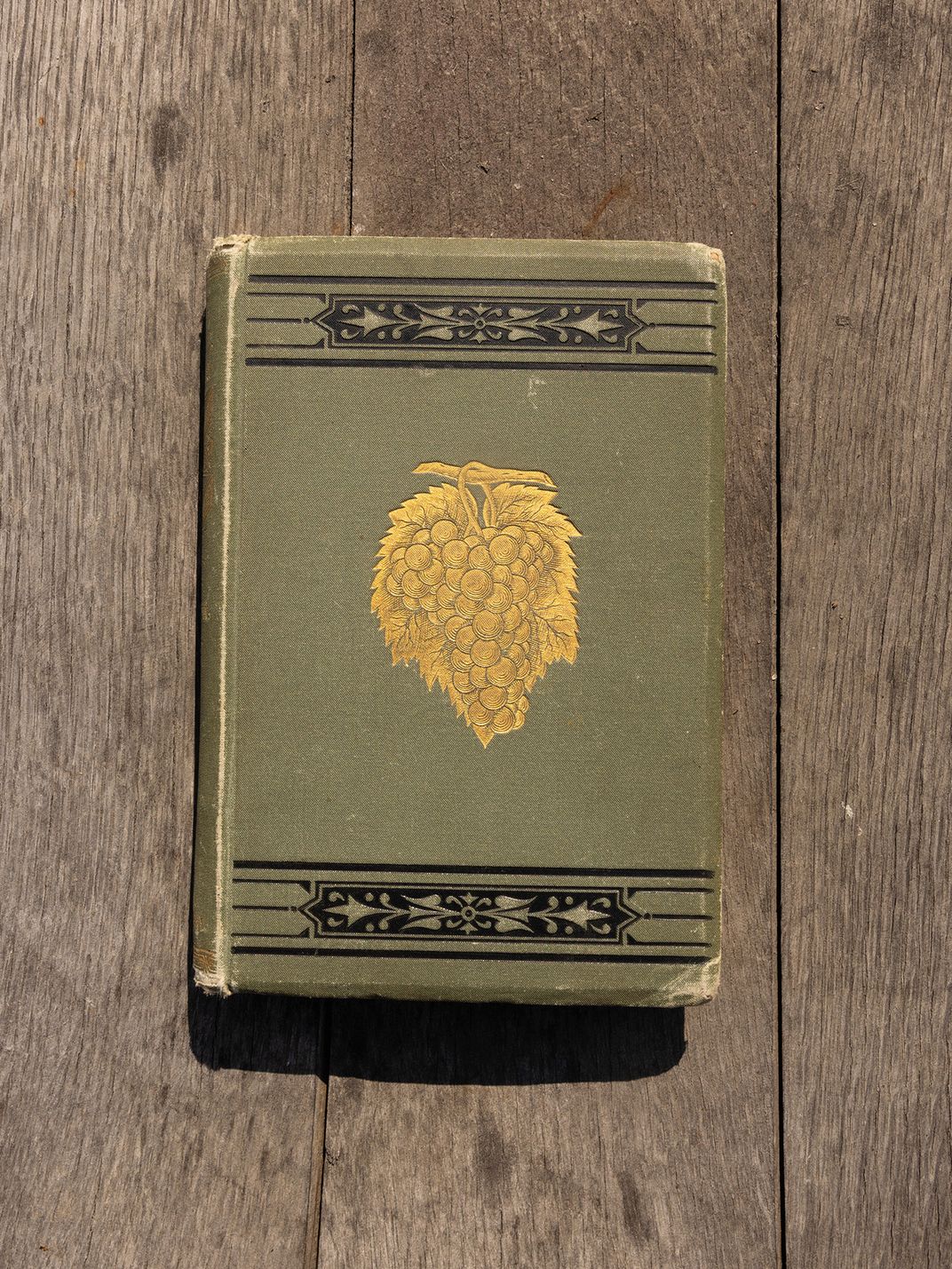
The author, a Texan, described breeding hundreds of native grapes that he sold widely, especially to winemakers in Missouri and the center of the country. When Eisterhold flipped to a diagram showing some of these grapes, he’d never heard of them. “The only thing to do,” Eisterhold recalls, “was to plant the grapes and see what they had to say.”
What began as an experiment grew into an obsession. As Eisterhold tracked down Munson’s native grapes, which had almost disappeared during Prohibition, he became ever more determined to restore respect and recognition to America’s original wine culture. Referring to the French wine critic who predicted, in 1873, that wines from across the U.S. would one day rival the best in Europe, Eisterhold likes to say, “He may still be proven right.”
But Eisterhold’s goal is not only to preserve and promote obscure grape varieties and forgotten flavors. As he delved into the history of American wine, he learned that these grapes once saved the world’s wine industry—and he believes they could do so again.
Grapes grow all over the world, practically everywhere birds fly and spread their seeds. Making wine is as simple as crushing the grapes and waiting—the juice is so high in sugar that yeasts on the skin will ferment the juice, creating alcohol.
For this reason, evidence of ancient winemaking has been found around the world. Patrick McGovern, an archaeologist and an editor of The Origins and Ancient History of Wine, traces the emergence of a consistent winemaking culture—of grape breeding and standardized fermentation practices—to modern-day Iran some 7,000 years ago, or possibly to Georgia, in the Caucasus, perhaps even earlier.
Egyptian pharaohs drank wine; so did some Chinese emperors. It was an elite beverage, generally made from one species of grape, Vitis vinifera, that grows in temperate climates like the Mediterranean. Commoners tended to drink beer, made from grain that grew everywhere.
In A History of the World in Six Glasses, the British author Tom Standage points to ancient Greece, where vinifera vines grew happily, as the birthplace of a wine culture shared by peasants and philosopher-kings alike. The Roman Empire adopted Greece’s wine culture, and its legions spread the vines across Europe.
When Europeans colonized North America, they brought vinifera with them. But the vines died within a few seasons, undone by unfamiliar pests like phylloxera, a tiny insect, or by the intemperately cold winters and hot summers. The highest-profile effort to cultivate European grapes in the Americas was led by Thomas Jefferson, who enlisted an Italian winemaker to grow vinifera vines in his Monticello garden with the help of his skilled staff of enslaved agriculturists. Like other farmers up and down the East Coast, they failed.
Reilly Johnson, one of TerraVox’s vineyard workers, picks Delicatessen grapes off the vine in September 2023, the same month TerraVox announced a larger and higher-quality harvest than usual. Jenn Ackerman + Tim Gruber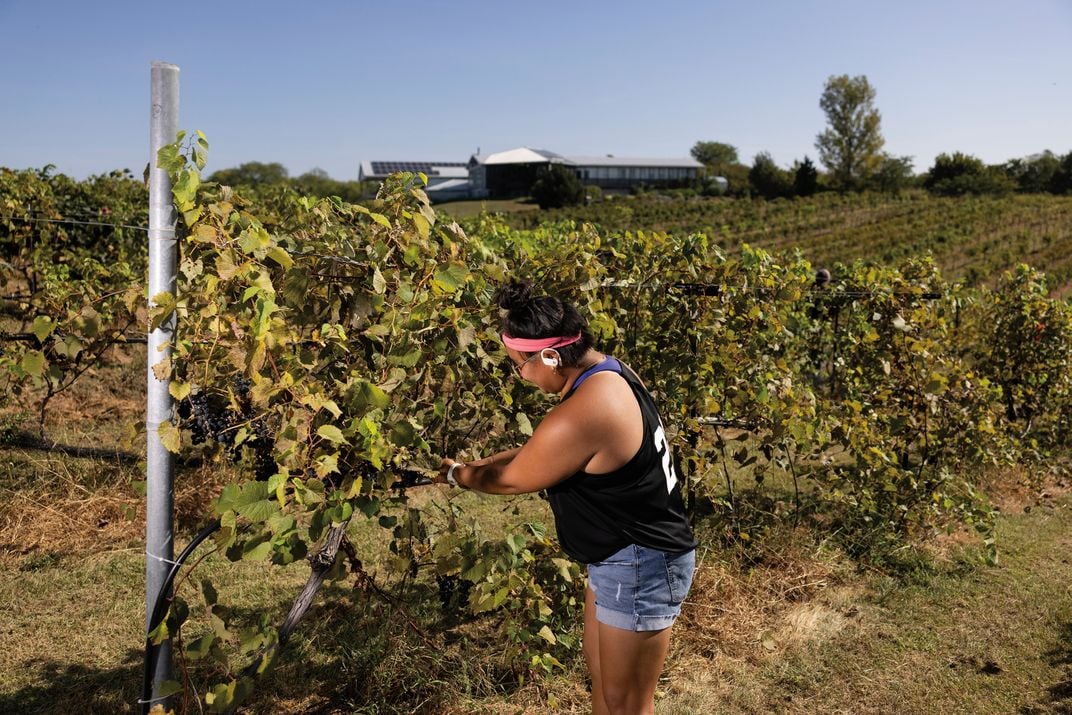
Jean-Louis Horvilleur, TerraVox’s winemaker, prepares Delicatessen grapes for processing. Soon, the yeast will be added to spur fermentation. Jenn Ackerman + Tim Gruber
But North America is home to the world’s greatest diversity of wild grapes, and Europeans marveled that native grapes grew seemingly everywhere. Unfortunately, most are not very edible, says Andrew Walker, emeritus professor of viticulture and enology at the University of California, Davis. Native American tribes gathered wild grapes for juices, jams and medicine, but there’s little record of their fermenting grapes into wine. Most are so acidic, Walker says, that grape breeders even today lose the enamel on their teeth from tasting them. Early Americans who tried making wine from local grapes complained that it had a “foxy,” “wet-dog” flavor.
Before the colonists’ vinifera vines died, however, the wind carried their pollen to wild grapevines nearby. In lucky cases, says Stephen Casscles, author of Grapes of the Hudson Valley, farmers in New York or Virginia might find—next to their withered European vines—a healthy hybrid that had inherited the American grape’s hardiness and the European grape’s flavors. And so North American grapes managed to form the base of a new American wine culture. By the early 1800s, America boasted wine regions in New York’s Hudson Valley, the area around Cincinnati, and elsewhere—all based on European-American hybrid grapes by then bred intentionally.
America’s most important wine breeder and researcher was none other than T.V. Munson. From his home in Denison, Texas, in the late 19th century he roamed thousands of miles on horseback and by train, literally jumping off both to collect wild grapes. And he recruited others to do the same, offering a $10 reward to whoever returned with the most promising find.
At the time, the Hermann, Missouri, wine region was built on the Norton grape, a French-American hybrid developed in Virginia. But most hybrids developed out East couldn’t thrive in Texas, Kansas and Missouri. So Munson, working primarily with wild native grapes, found and bred some 300 grapes for the center of the country—some for eating, many others for wine. His grapes helped build the foundations of wine industries in regions where vinifera could not survive, from Texas to Florida. It was the world’s only robust, non-vinifera wine culture.
But Munson did not receive France’s Legion of Honor Chevalier du Mérite Agricole for breeding grapes for wine connoisseurs from Texas and Missouri. He received his agricultural knighthood for saving the European wine industry.
By the 1860s, phylloxera from North America had reached France, hitching a ride on grapevines imported by European botanists. (The reduced travel time of steamships likely allowed the insects, which eat the sap of grapevines, to survive the trans-Atlantic journey.) Within a few years, phylloxerae cut French wine production in half and invaded millions of acres across Europe. Winemakers flooded their fields in desperation, and the French government announced a 300,000-franc reward for a solution.
Familiar with Munson’s reputation, a French representative sought out this prolific American viticulturist. Munson suggested grafting French vines onto the rootstock of American grapevines, which had developed resistance to the insects over many generations. French vintners had already tried grafting and failed. But with his encyclopedic knowledge of American grapes, Munson suggested specific Texas grapevines that grow in chalky soil like that of Southern France. These grapes ultimately saved Europe’s vineyards. To this day, all of Europe’s famous grapes grow on vines that have been grafted onto American rootstock to protect against phylloxera.
American vineyards faced their own deadly foe in the temperance movement. Like the rest of the country’s vineyards, Munson’s personal vineyard was uprooted during Prohibition. Munson had died in 1913, and by the 1950s, he was mostly forgotten.
In the following decades, winemakers all over the world used modern pesticides in intensive efforts to grow varieties of vinifera, particularly the so-called noble grapes. These six grapes—Pinot Noir, Cabernet Sauvignon, Merlot, Chardonnay, Sauvignon Blanc and Riesling—originally hail from France or Germany. Along with a handful of other European grapes, such as Syrah, also a vinifera variety, they still dominate the fine wine industry.
Even today, the most respected wine regions in the United States, including parts of California, Virginia and New York, are those that manage to grow vinifera. And those where only European-American hybrids will thrive, including the area around Hermann, Missouri, are considered second-tier or even irrelevant.
Eisterhold never intended to get into the wine industry. When he left the family farm for agricultural college in Columbia, Missouri, in 1969, he studied soil, but he found his art classes more intriguing. “My reasoning was that you go to school to learn something that is unfamiliar to you—not what you know,” he says. He transferred to the Kansas City Art Institute, learned graphic design and graduated to a job at the Kansas City Museum as an exhibit designer. Six years later, he opened his own studio to help museums design new exhibits and experiences.
He still runs Eisterhold Associates Inc. today, with a client list that includes the Harry S. Truman Presidential Library and Museum in Independence, Missouri, and the Jurassic Park Discovery Center in Orlando, Florida. He’s best known for working on some of America’s first civil rights museums and exhibits, like the Rosa Parks Museum in Montgomery, Alabama, and Philadelphia’s African American Museum.
It was on that business trip to Lincoln, Nebraska, in the early 1980s, when he stumbled on the book that changed his life. Like a Rosetta stone, Munson’s dusty old book offered a record of a lost culture: grapes and wines that had been bred, shared and enjoyed across the Plains and Midwest. Returning home to Kansas City, Eisterhold was inspired to try making them himself. But he couldn’t find any nurseries that stocked Munson’s grapes. So he wrote to an administrator at Grayson, a community college near Munson’s long-closed nursery in Texas, hoping that Munson’s vines might still be growing there, and asked for any cuttings they might be willing to provide.
Throughout the harvest season, TerraVox isolates each variety for frequent lab tests—for sugar, pH levels and more—that will indicate the exact best time for picking. Jenn Ackerman + Tim Gruber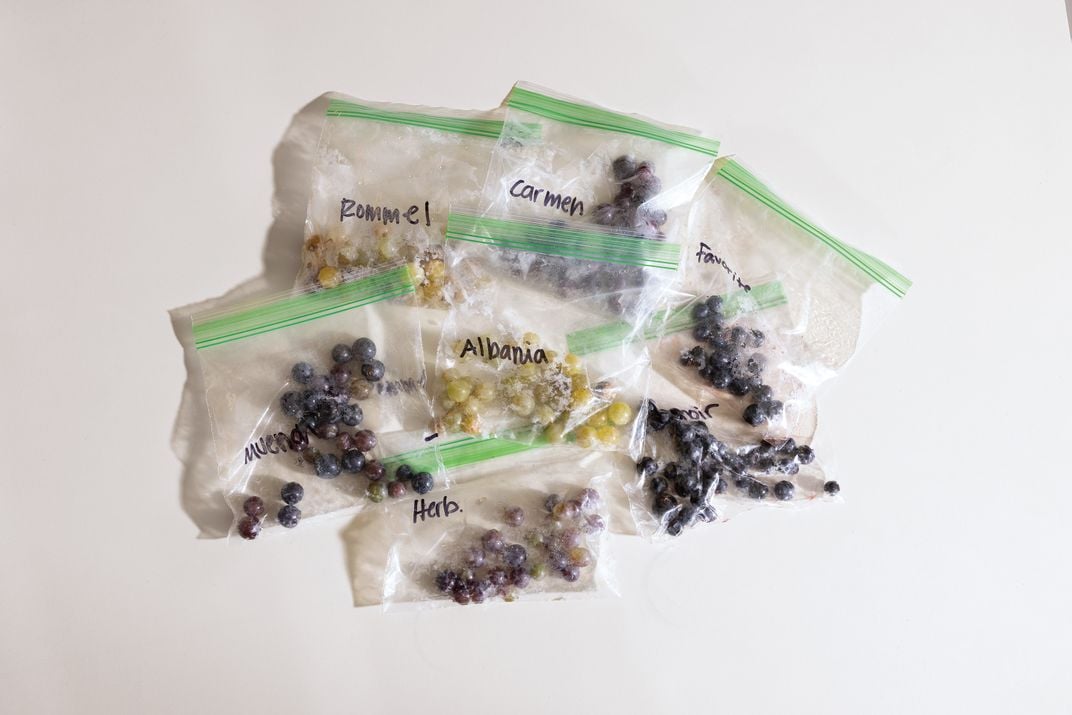
What came back in the mail looked like a bundle of sticks. Eisterhold stuck them in the ground and watered them with a garden hose, but his backyard was too shady, and critters stole the few grapes that grew.
Undeterred, in 1994 Eisterhold chartered a plane to find a site where he could build a home with a proper vineyard. From working on soil surveys in college, he knew which spots would be fertile but not so rich in organic matter that lush growth would overwhelm the vines. From the sky, he sought out suitable areas that were undeveloped and relatively close to Kansas City’s Nelson-Atkins Museum of Art, where his wife, Kate Garland, worked as a conservator. They were in luck: One promising site was for sale.
As it happened, Garland had an uncle who taught at the University of California, Davis, home to a prestigious viticulture program. So on weekends the couple flew to California, stayed with her uncle and took extension courses.
At first, Eisterhold planted around 60 varieties of Munson grapes, which he sourced from Grayson and from agricultural repositories at Davis and in Geneva, New York, that stockpile seeds and plants. (He guessed, correctly, that Munson’s renown had led these genetic banks to hold on to these old grapes for researchers and breeders.)
He also planted rows of Norton, the well-established French-American hybrid, figuring that if the Munson grapes failed, he could at least sell Norton to other winemakers. And he planted other hybrids and even a vinifera, since he thought it would be neat if he managed to make some Zinfandel. (There are thousands of named vinifera varieties, including hugely popular grapes such as Tempranillo and Moscato.)
It took several years to set up trellises and coax the vines to grow, but in 2000, Eisterhold finally harvested grapes on his land. It didn’t go so well: He managed to gather enough grapes to produce exactly one bottle of wine, a hodgepodge vintage made from a few grapes from each vine. Eisterhold keeps it on display in the TerraVox tasting room, unopened. “It’s better as a story,” he says. “I’m sure it’s god awful.”
His University of California, Davis, classes helped him diagnose the vineyard’s problems: He needed a drip-irrigation system for the new vines, even though the hardy plants would rarely need it once they matured. He had to weed more. Sprays that killed pests were probably self-defeating since they also killed the pests’ predators.
Eisterhold’s biggest challenge, though, was the terrible reputation of American grapes. Even many breeders and sommeliers interested in local wines consider them subpar. Rather than share his plans with other winemakers, then, Eisterhold says he “learned to shut up” about Munson’s grapes.
Luxuriant bunches of the experimental grape known only as 09-28-2. Jenn Ackerman + Tim Gruber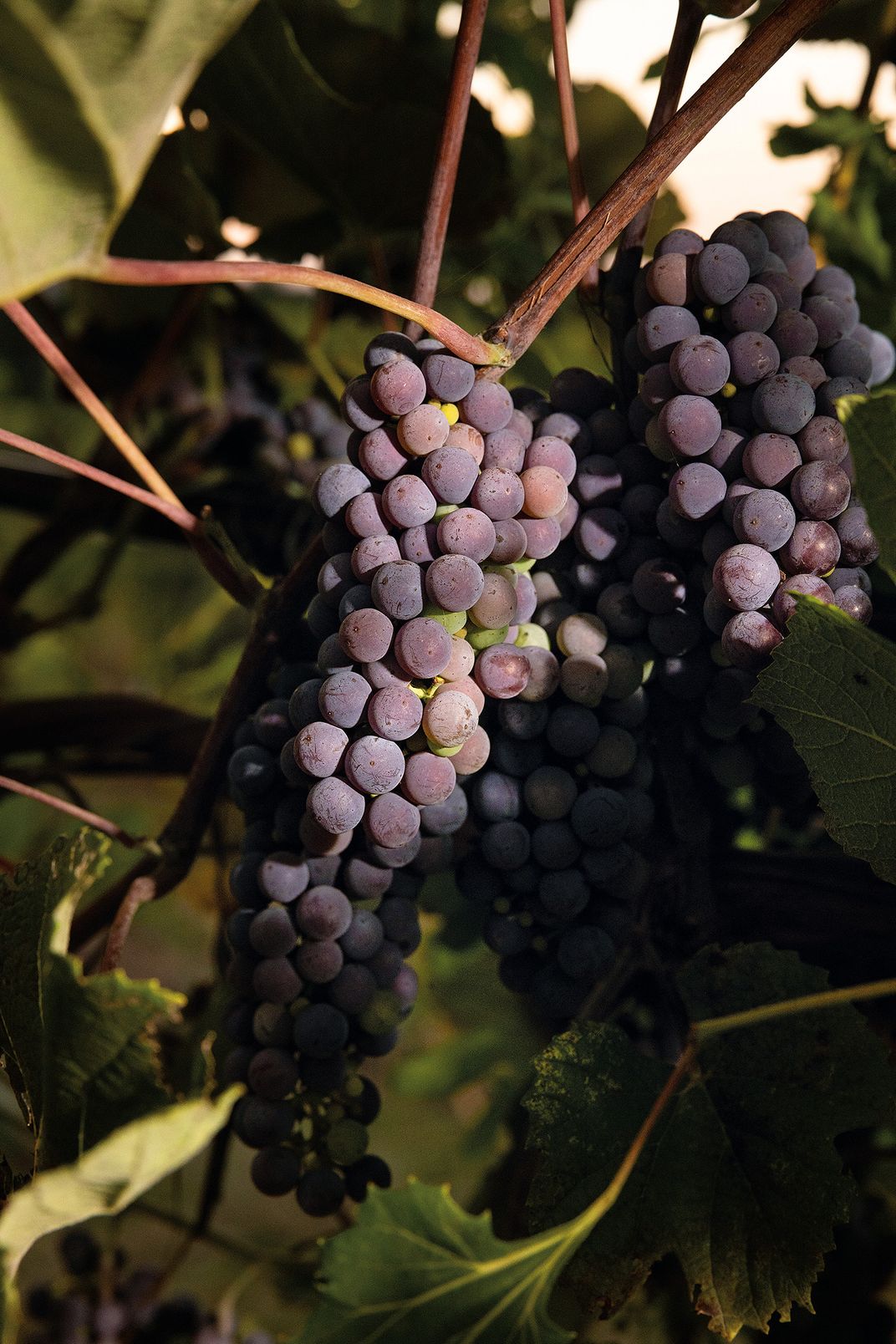
To convert grapes into wine, workers at TerraVox add yeast to crushed Delicatessen grapes—and the magic of fermentation begins. Jenn Ackerman + Tim Gruber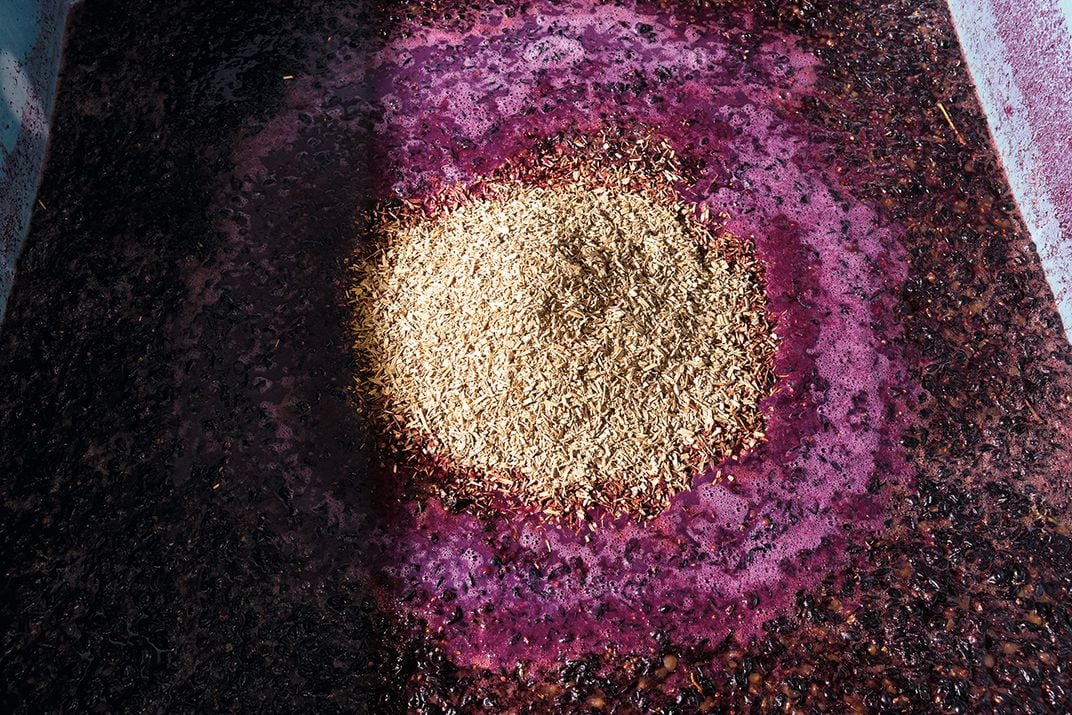
The next year, the vines fruited, and Eisterhold invited friends to help with the harvest and winemaking. (He compares himself to Tom Sawyer, promising a good time, then recruiting new folks each year after the previous crew realized how much work was involved.) When Eisterhold tried the wine they made from Munson grapes, one or two tasted terrible, and he abandoned those vines. Most tasted fine, although Garland, who is French-American, tried only a few sips, passing ambivalent judgment with her body language, or what Eisterhold calls a “Gallic sniff.” If Missouri was destined to be the next great wine region, it wasn’t clear from these first vintages.
Eager to improve them, Eisterhold ditched most of the hybrids to focus on Munson’s native grapes. “Other people were growing hybrids,” he says. “The thing that needed to be done—because literally no one else was doing it, because it made no sense to do it—was to pull some of these grapes out of the dustbin of history.” Finally, in 2011, he sent a package of 24 small vials to one of his former teachers at Davis, a wine consultant named Clark Smith.
When Smith poured their contents into glasses, they were clearly wine, but he didn’t recognize the names on the labels: Lomanto, Hidalgo, Lenoir. “I almost thought it was some kind of practical joke,” Smith says. But Eisterhold had now harvested Munson grapes for more than a decade. (They’d improved enough that his wife even deigned to drink them.) “I tasted the wine,” Smith went on. “There were some technical flaws. But a lot of them were just plain good. … I thought Jerry was really on to something.” He agreed to visit Eisterhold’s vineyard, and by the end of his tour, he’d suggested that Eisterhold “just go for it” and open a commercial winery.
Smith, who became an adviser, helped Eisterhold hire and train staff and design a floor plan for a winery connected to his house and the offices of Eisterhold Associates Inc. They broke ground on TerraVox that spring. The name means “voice of the land,” a reference to Eisterhold’s belief that working with local grapes is a conversation between him and the grapes.
“Some of these wines will take you on flavor journeys that you don’t find anywhere else,” he says. One of the grapes, which Munson named America, tastes, remarkably, like meat. Another, Cloeta, tastes of cinnamon with smoky notes, which is common in dark beers and spirits such as Scotch, but rarer in wine.
Like a museum curator, Eisterhold continued to collect additional Munson grapes, such as Delicatessen, which he requested from a small Midwestern winemaker who had entered it in an amateur wine competition. He has never made profit-and-loss statements, instead subsidizing TerraVox with personal savings and not taking any salary himself.
To converse with Munson’s grapes and realize their value often requires a spirit of experimentation and uncommon patience. During my visit, TerraVox’s head winemaker, Jean-Louis Horvilleur, a well-bearded, Birkenstock-clad man whom Eisterhold and Smith hired away from a Texas winery in 2019, described how during his first harvest the challenge of working with dozens of unfamiliar varieties literally gave him nightmares. There were no ready-made charts, based on hundreds of years of winemaking tradition, telling him when to harvest the grapes according to their sugar and pH levels, or how the grapes and wine would change if he waited—as there were for, say, the Tempranillo he used to work with back in Texas. “There’s more looming fears with these grapes,” he says. “More uncertainty.”
One of Horvilleur’s main duties, once a vintage is ready, is testing alcohol content; TerraVox’s wines generally range from 7 to 21 percent alcohol, with most closer to the former. Jenn Ackerman + Tim Gruber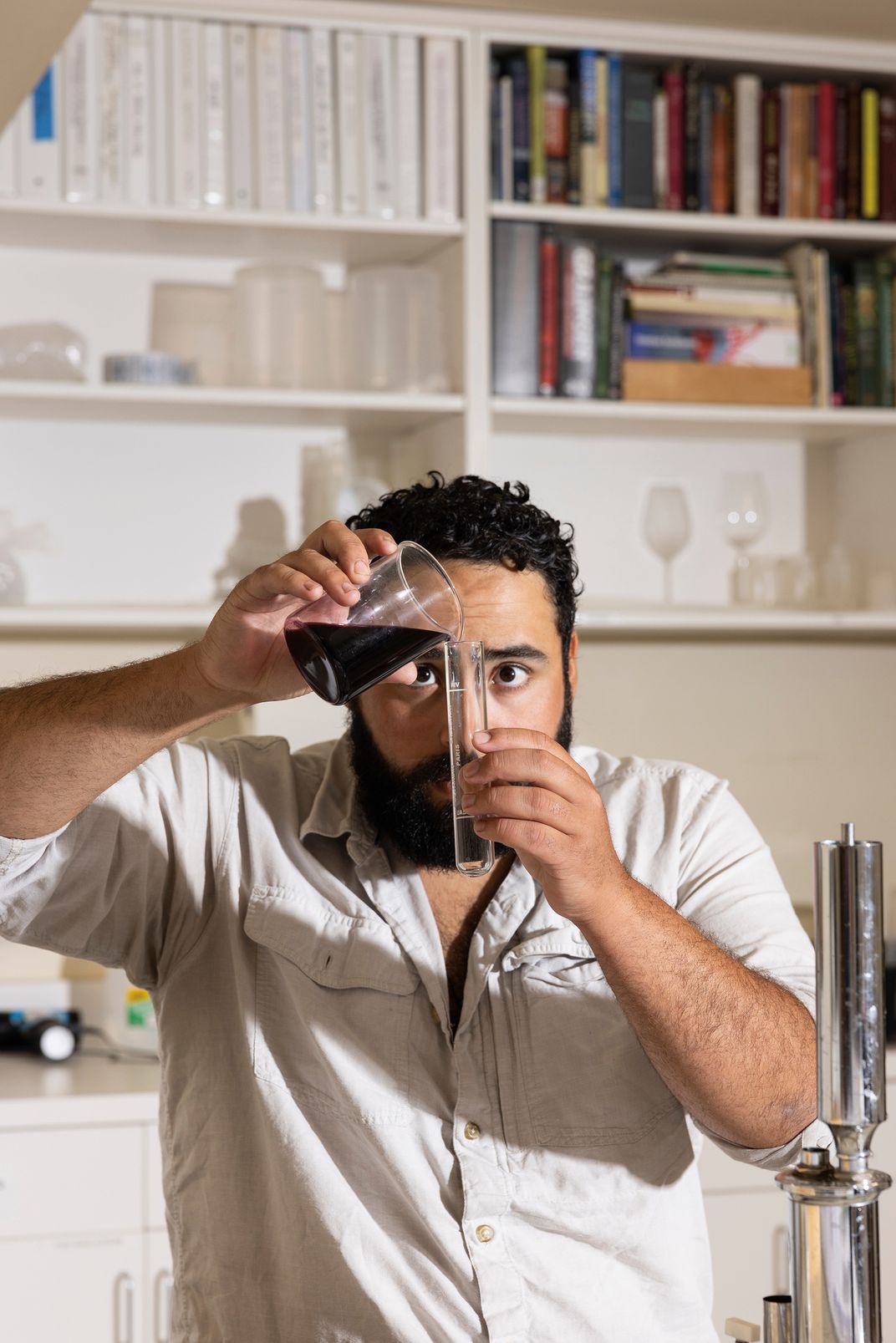
On a glass door in the TerraVox laboratory, Horvilleur records the progress of the Wetumka grape, including overall weight, expected volumes per grape and more. Jenn Ackerman + Tim Gruber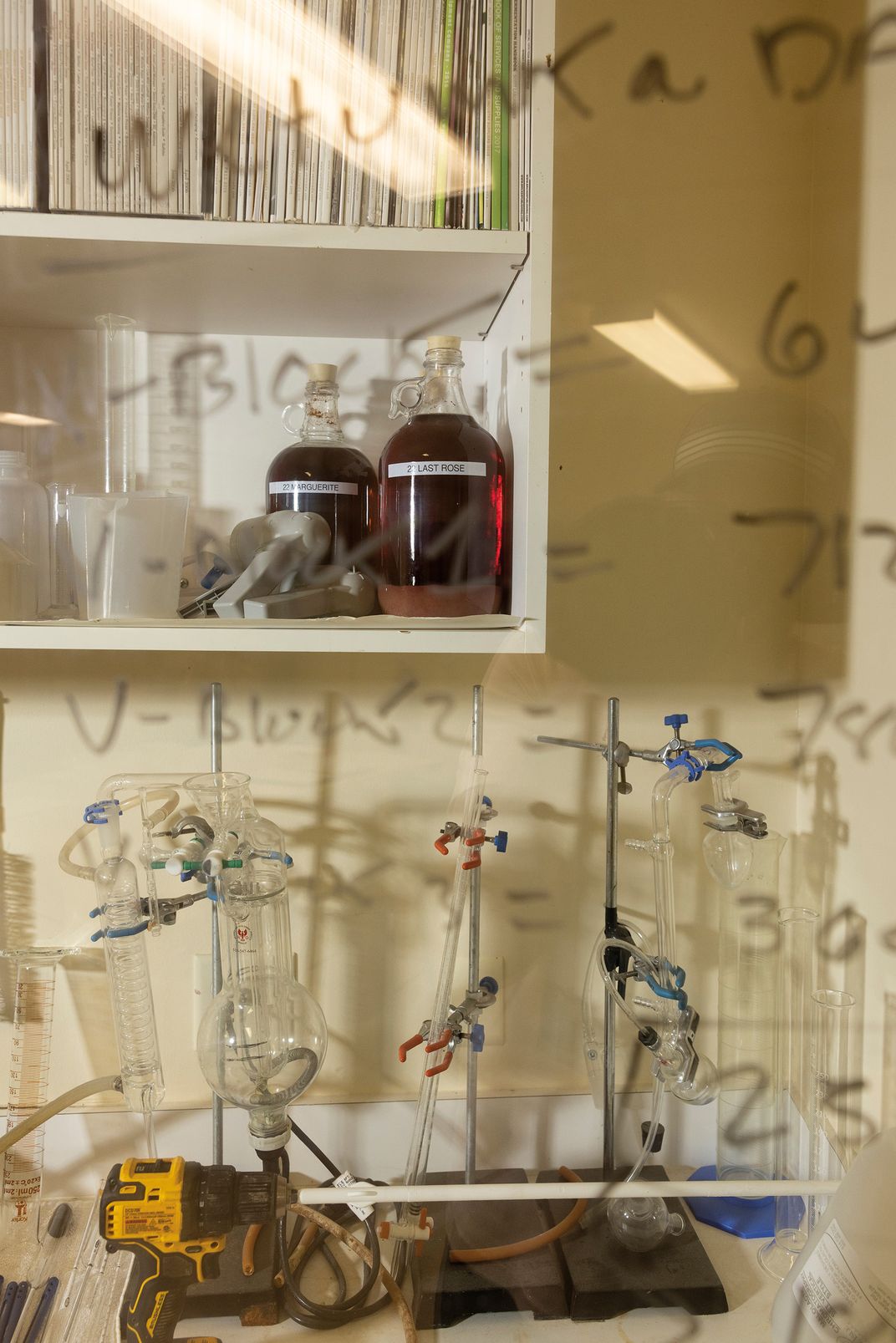
That uncertainty can lead to creative problem-solving. During that same harvest, Horvilleur loaded a batch of Wetumka, a bright-green grape that Munson first bred in 1893, into TerraVox’s wine press. The grapes were so pulpy that the press couldn’t separate the skins and flesh from the juice, which sprayed onto the walls and ceiling.
Horvilleur, soaked and sticky, ended the day scraping fruit matter from behind his ear as he measured the disappointing yield of juice.
But he made a note for next year: He’d pitch Eisterhold on fermenting the grapes with their skins on for a day before pressing, which would produce an orange wine—a style that’s grown in popularity for the past decade—and might break down the pulp. A year later, in 2020, they successfully produced a cheery, almost-tropical orange Wetumka that is now a fan favorite.
The Wetumka is what Eisterhold sometimes calls a “good missionary” for his historic grapes. He and his staff increasingly abandon varieties that don’t produce winning wine, winnowing their plantings from 60 grapes toward a target of 20, and in recent years TerraVox has received gold medals and silver ribbons from the San Francisco Chronicle and other wine arbiters. “One of the secrets of making good wine is that a hell of a lot of stuff has gone down the drain,” Eisterhold admits. “Because we can’t afford to have a bad missionary out there.”
When I ask him if he feels he’s succeeded in earning respect for Munson’s grapes, Eisterhold replies, “Not yet.” While TerraVox has produced palate-pleasing missionaries like Wetumka, he aspires to create a big market of customers devoted to American grapes, and even to cultivate champions that, as the 19th-century French wine critic predicted, would make Missouri a marquee destination for wine-lovers.
Today, as in Munson’s day, North American grapes have something unique to offer the wider wine world: Their unusual hardiness and tolerance of heat are distinct advantages at a time when the warming climate is already affecting harvests, with grapes ripening weeks earlier than in decades past and wineries struggling with water shortages, wildfire smoke and springtime frosts. Forecasters predict that eventually climate change could shut down as many vineyards as phylloxera once did (albeit with the twist that colder regions, like England, are seeing improved production).
At the moment, winemakers are not racing to uproot their “noble” grapes and replace them with American grapes, but the slow machinery of the global wine industry is beginning to adapt to evident threats. One organizing body in France, for example, recently gave Bordeaux vintners permission to use six new grape varieties (all vinifera, but less popular and more heat-tolerant) in their strictly controlled blends. Eisterhold has sent cuttings to European breeders who are concerned about climate change. And a small but expanding number of wineries and restaurants in the Northeast and Midwest are growing and selling French-American hybrids, attracted by their resilience and sustainability.
Eisterhold says the potential for native grapes to make the wine world more resilient, by increasing its genetic diversity, has always been central to his project. Growing more kinds of grapes, he says, “hedges your bets as we deal with what, I think, will be an increasingly uncertain and volatile future.” At the very least, wine breeders could develop new grapes that contain trace amounts of North American varieties—just enough to provide benefits like heat tolerance. At Davis, Walker bred grapes with resistance to Pierce’s disease, which kills vinifera but not American grapes, that was still 97 percent vinifera. The implicit promise is to provide resilience while minimally sacrificing flavor.
But if Eisterhold can help to garner respect and recognition for local grapes, that could go a long way toward convincing winemakers—and wine drinkers—that turning to non-European grapes is not a sacrifice or a downgrade but rather an opportunity for exploration.
Visitors enjoy a September 2023 wine tasting at TerraVox. Tastings generally last from an hour to 90 minutes. Jenn Ackerman + Tim Gruber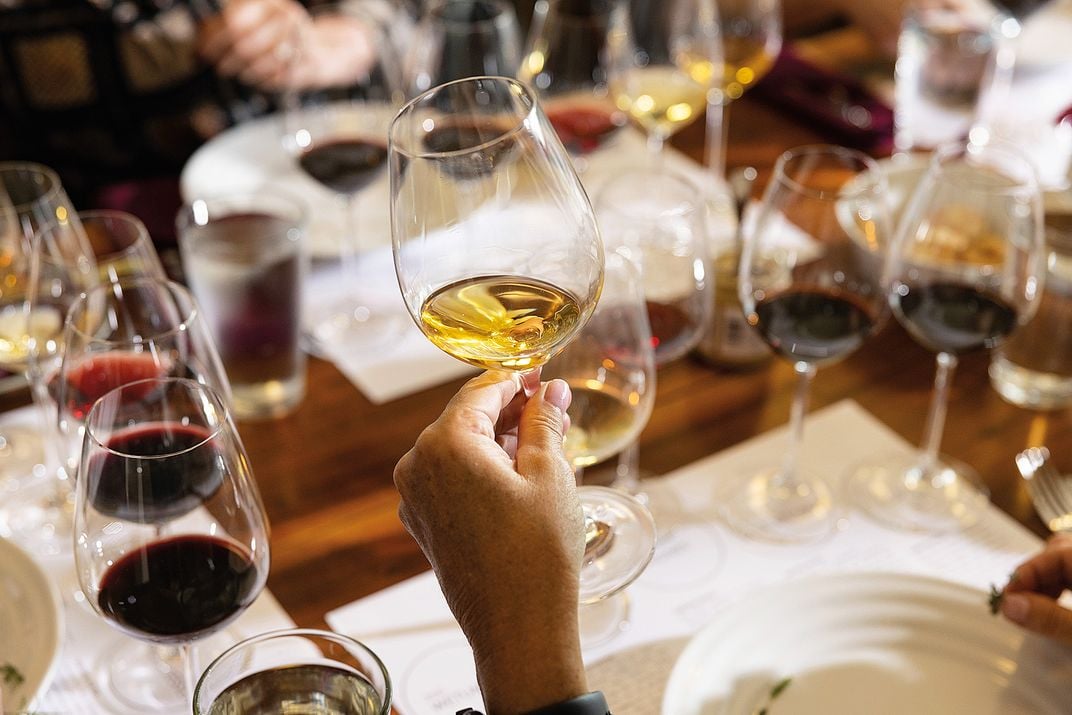
During the end of my visit to TerraVox, I’m struck by the contrast between these grand ambitions and the day-to-day work on the vineyard. At a tasting of five TerraVox ports, a group of guests listens attentively to Horvilleur explain the history of Munson’s grapes. Eisterhold adds that “until Prohibition, Missouri was the Silicon Valley of wine.” The patrons politely accept forms to sign up for a TerraVox wine club. Most tell me they came to enjoy a creative date night or catch up with friends. I find myself wanting to shake them, to make them understand how unique these wines are, how unlikely it is that this winery would even exist.
At the end of the evening, as I stand on the balcony of the tasting room, Eisterhold walks up to me. His cheeks are ruddy. From the sun, perhaps from the wine. He nods toward the nearest rows of vines, where earlier he’d showed me how to prune the canopies to ensure airflow through the vineyard. “I finished the section,” he says proudly.
This is what obsession and contrarian ambition look like: Eisterhold in his wide-brimmed hat, shears in hand, making his way slowly down the row, methodically restoring a living thing from historical obscurity and shepherding it into the future. Each year he learns more about these grapes, and he believes there are dimensions yet to be discovered. “These grapes deserve to live here because they came from here, they’re adapted to here,” Eisterhold told me. “Why haven’t they been nurtured?”
Recommended Videos







